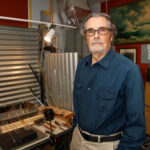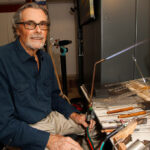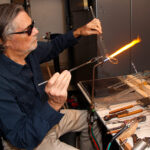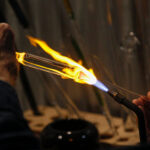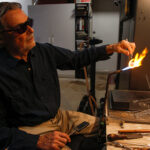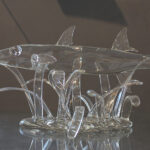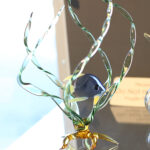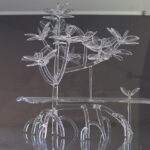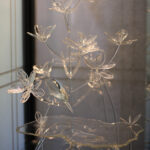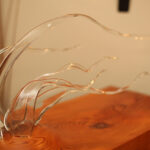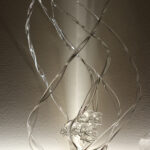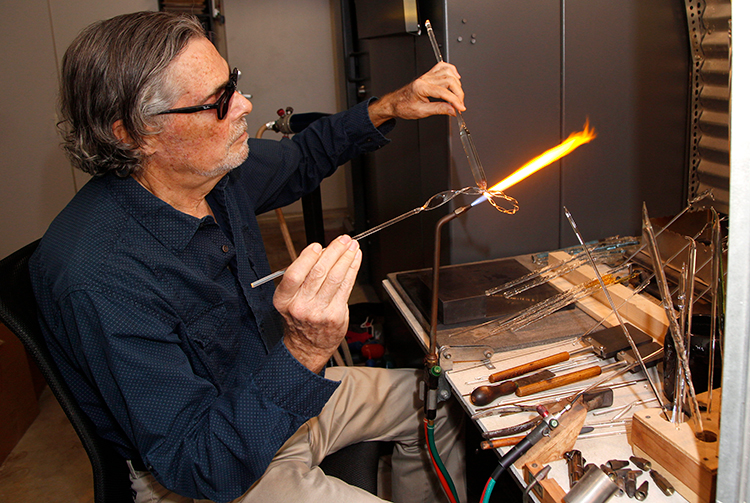
Some would say that artist Michael Robinson, whose work is represented by Gallery 14, was destined to spend his life manipulating the amorphous nuances of glass. His earliest memories are of watching his father, who worked in the glass trade, make little animals at home.
“That really makes an impression on a young mind,” says Robinson, who still uses some of his father’s tools in his work today.
Robinson, now age 70, emigrated to the United States from Perry Vale, England, with his family when he was just 5 years old. His father had worked in the neon trade in England where he learned the art of glassblowing by making neon signs.
Over the years, Robinson continued to study the glass trade at his father’s knee and cut his teeth on hard glass while making vacuum tube bases for ultraviolet light detectors in New Jersey during high school summer breaks.
“They were very difficult to make,” he recalls. “You really learn temperature control on the glass.”
Robinson and his father would later open their own neon shop on the Jersey Shore, where they crafted ornaments on the side.
“Neon is tricky. You learn an awful lot of control on glass doing stuff like that,” he recalls. However, he admits, “I got better at the ornaments than I was at the neon.”
As their business gradually shifted away from neon and toward creating more glass ornaments, they opened a shop in Beach Haven, on Long Beach Island, New Jersey.
Robinson says that his experience working with several types of glass helped him to define his technique, while also forcing him to figure things out on his own.
“I could just fumble my way through it and see right to it. A lot of that was from watching glass move and flow in the flame,” he explains.
Robinson says his technique is that of a lampworker, which is more often called glassblowing. Lampworkers manipulate glass using a torch rather than blowing through a blowpipe to inflate the molten glass.
Evidence of glassblowing dates to 3500 B.C. in Mesopotamia and has evolved over the years. The earliest glassworkers used alcohol or oil lamps and bellows to create a usable jet at a high temperature. Today, Robinson uses a propane-fueled torch that emits a flame of about 4,500 degrees, which turns the glass into a molasses-like texture.
In the 1980s, Robinson and his partner, Diane Richards, bought a trawler and traveled down the Intracoastal Waterway to Islamorada, where he eventually opened the Spectrum Studio Gallery in the area’s Rain Barrel Artisan Village.
It was there that Robinson streamlined his line of glass ornaments. He says that, inspired by the native flora and fauna of the area, he turned his blow torch and considerable skills toward creating the exquisite creatures the Florida Keys are known for.
He sees glass as the perfect medium to express the forms found in nature.
“Glass echoes nature; it is enduring but fragile. Careless action can destroy a glass object (or a natural ecosystem) that would otherwise exist for eons,” Robinson stresses.
“We settled into making designs that were tropical in nature, instead of having dragons and elephants, which is a staple of glass ornament shops. I try and make things that are very pleasant to look at and evoke emotion in things that are available in nature,” says Robinson.
He adds that he feels it is important for artists to cultivate their own style and expression.
While he has created a limited selection of colored glass pieces in recent years, Robinson says he prefers to work with clear glass.
“When you use color, it somehow becomes less of an approximation. It becomes more of an exact thing. With the clear glass, you’re letting the viewer’s imagination run.”
As a medium, Robinson finds glass fascinating, explaining that it takes a steady hand to gently coax it into shape.
“Glass is an inherently beautiful material. The fact is that you can heat it up and use what it does, how it flows, all its natural characteristics, to get it into a shape that you desire,” he explains.
The irony that he uses the nature of glass to create sculptures that depict nature isn’t lost on Robinson, who talks about the molten glass almost as if it were a living, breathing thing.
“The nature of glass can be either disregarded or employed to produce a piece that is perceived on different levels, for glass is a paradox,” he says, explaining that glass is a “manufactured material” that possesses an “elemental feel.”
Robinson further comments that the elemental nature of glass gives it “its own presence as a medium,” that by its own very nature “exerts a great deal of influence on the finished product.”
Robinson describes working with glass as a hurry-up-and-wait job.
“When you get the glass at the right temperature, it will just flow together. The trick is to let it flow back on itself.”
“What I like about the glass is when it’s done, it’s done,” he adds.
Many of Robinson’s sculptures tell a story. In “Stay in School,” he catches a school of fish hiding among the mangroves, with one wayward fish meandering away as a green heron watches from the bushes. The sense of danger for the hapless, lone fish is palpable.
With “Dune Fence,” a wave crashes as a seabird alights atop a fence. You almost hold your breath in anticipation, hoping the bird was able to fly off before the sea washed into the rickety boards.
Two other pieces on display at Gallery 14 engage dolphins but in quite different ways. The dolphins leap with glee in “Dolphin Pod,” while in “Deep Water” they appear to be interacting in an elegant dance.
A sense of serenity is evoked in “Still Waters,” where a glass pool of water lets the onlooker gaze into the watery silence of a mangrove, from its intricate root system below the surface to the leafy green leaves above.
In “Reef Idols,” a trio of angelfish appear to have a symbiotic relationship with the seagrass, as they weave in and out to a tune only they can hear.
Robinson is a represented artist at Gallery 14 with various works on display. For more information, visit gallery14verobeach.com.
Photos by Kaila Jones

